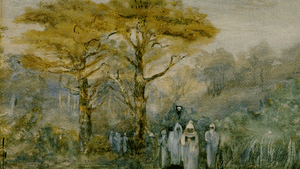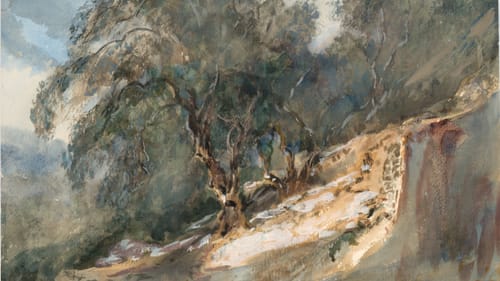Stay in the Loop
BSR publishes on a weekly schedule, with an email newsletter every Wednesday and Thursday morning. There’s no paywall, and subscribing is always free.
One of the cracked people
Delaware Art Museum's Politics and Paint: Barbara Bodichon and the Pre-Raphaelite Brotherhood

Her work has been ignored, underrated, and practically erased. But Barbara Leigh Smith Bodichon (1827-1891) was a feminist leader, fearless traveler, and dogged working artist. At the Delaware Art Museum, curator Margaretta Frederick has assembled Politics and Paint: Barbara Bodichon and the Pre-Raphaelite Brotherhood, illuminating this fascinating woman.
Though few of her finished artworks still exist, Bodichon stood at the center of a Victorian network for the empowerment of women. By her own definition, she was “one of the cracked people of the world, and I … am never happy in an English genteel family life.”
In an intimate gallery, this exhibition melds the iconoclastic artist and her lost history. Most of the artworks are untitled and undated and — taken from journals and notebooks — are studies for the finished works Bodichon undoubtedly created and sold.
Impressing the Impressionists
Because they are largely working sketches, the 30 works in Politics and Paint show Bodichon’s wide-ranging interests. Two open sketchbooks are exhibited in a vitrine, with a page-turning film above showing their contents.
Bodichon experimented with textured paper to add dimension and movement, working en plein air “decades ahead of the Impressionists,” according to Frederick. Two undated watercolors — A Hooded Procession and Boats in the Rain — look ahead in technique, but their subject matter echoes the mystical art of William Blake, whose work she would have known.
The artist was an activist and champion of women’s rights. In 1857, she cofounded the Society of Female Artists to provide exhibition opportunities for women, and in 1858 she cofounded Girton College, the first women’s college in Cambridge, England. That same year, Bodichon and Elizabeth Parke cofounded the English Women’s Journal. A published pamphlet on display, Reasons for the Enfranchisement of Women, is credited to “Madame Bodichon.”
Among the straightforward drawings and watercolor studies are some quirkier works. Bodichon’s passions merge in Effects of Tight Lacing (c. 1858), a drawing depicting the health risks of extreme corseting. Made for her magazine, it features not only clothing and female anatomy but suggestively placed skeletons and skulls and the words “death” and “Ha! Ha! Ha!” to drive home her message.
{photo_2}
Tour-de-force
As if art and advocacy weren’t enough, Bodichon was also an avid traveler. At 23 she toured Europe unchaperoned, and often traveled by horse and mule. Marriage did not deter the artist from her pursuits, and she often traveled with her husband Eugène — a doctor she met on a family vacation in the trendy holiday destination of Algeria.
In 1857, shortly after their marriage, the couple traveled for six months in the United States. They toured the Eastern seaboard (coming through Delaware) and went to the pre-Civil-War South, where they studied slavery and lived for three months in New Orleans.
One of the exhibition’s striking images is Swamp in Louisiana (1858), a published wood engraving. It shows Eugène in semi-Algerian garb holding a rifle and watching for alligators while his wife paints.
The couple lived in London (where Bodichon pursued her political activism) and in Algeria (where she painted). Iconoclastic and opinionated, in the 1850s she befriended Dante Gabriel Rossetti and the pre-Raphaelites, the most avant-garde artists of the day, and in 1864 she went to the French village of Barbizon to study with Corot, a forerunner of Impressionism.

"A past that got erased"
Frederick says she mounted this exhibition “to recover the life of a female artist and try to recreate a past that got erased.” Bodichon exhibited at London’s French Gallery (one of the first to sell contemporary British art) and her works were well reviewed. She also exhibited at the Royal Academy (the male British bastion that had only recently admitted women) and was part of the 1857 traveling exhibition English Art in America, seen in Washington, Boston, and Philadelphia. But virtually all of these artworks disappeared into private collections or were lost.
For that reason, it’s especially valuable that the museum’s deep and justly renowned collection of pre-Raphaelite art hangs in adjacent galleries. There we see Bodichon among her peers with one of her few large extant works, Ventnor, Isle of Wight (1856), a masterful watercolor that Frederick acquired for the museum.
Some works in the exhibition are drawn from the Mark Samuels Lasner Collection (University of Delaware); others Frederick recently found in a family collection in Switzerland. Private collections are often the only way such works are preserved, and one of the aims of an exploratory exhibition and visual biography like this one is to open a path to more Bodichon discoveries.
What, When, Where
Politics and Paint: Barbara Bodichon and the Pre-Raphaelite Brotherhood. Through February 3, 2019, at the Delaware Art Museum, 2301 Kentmere Parkway, Wilmington, Delaware. (866) 232-3714 or delart.org.
Sign up for our newsletter
All of the week's new articles, all in one place. Sign up for the free weekly BSR newsletters, and don't miss a conversation.

 Gail Obenreder
Gail Obenreder